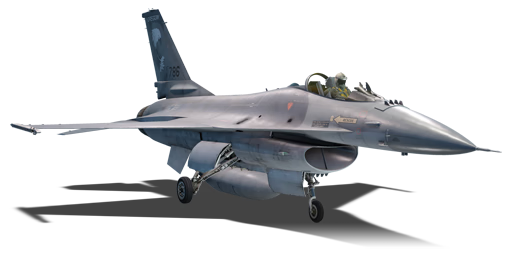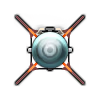



After the USAF Air Defense Command was dissolved, the Air National Guard (ANG) took up the task of defending American airspace in the mid-1980s. The F-16, which had only been introduced several years prior, was selected, and 270 F-16A/B airframes were converted to the ADF (Air Defense Fighter) standard. The first production variants of the F-16 could not utilize the AIM-7 Sparrow, so the ADF included that feature. It also featured the AN/APX-109 IFF system and a spotlight for illumination during nighttime operations. Conversions were conducted at Ogden Air Logistics Center and carried on for 3 years. After the threat of Soviet bombers was over, many of the F-16 ADFs were either reconverted back into F-16A/Bs, placed into storage or sold off to other countries.
Introduced in Update "Apex Predators", the F-16A ADF is a very powerful fighter thanks to its radar missile capability, dogfighting abilities, and overall performance. Firstly, the F-16A ADF can carry the AIM-7M Sparrow, which is useful for medium to long-range engagements. The ADF can also equip all-aspect AIM-9L Sidewinders, which have a decently long range for an infrared missile. Since the ADF was simply a conversion of the regular F-16A variant, it features the same engine and mostly the same airframe. However, the extra weight added by the various electronics and systems does increase the weight by around 280 kg (617 lb). Also, since the ADF was intended for interception, it lacks suspended armament and is mainly relegated to air duties. Nonetheless, the F-16A ADF is still overall an excellent aircraft.
flaps
flaps
flaps
brake
| Belt | Belt filling | Armor penetration (mm) at a distance: | |||||
|---|---|---|---|---|---|---|---|
| 10 m | 100 m | 500 m | 1000 m | 1500 m | 2000 m | ||
| HEF-I/API-T/AP-I | 40 | 36 | 22 | 12 | 6 | 3 | |
| HEF-I/HEF-I/API-T/HEF-I/HEF-I/AP-I | 40 | 36 | 22 | 12 | 6 | 3 | |
| API-T/AP-I/AP-I/AP-I/HEF-I | 40 | 36 | 22 | 12 | 6 | 3 | |
| HEF-I/AP-I/AP-I | 40 | 36 | 22 | 12 | 6 | 3 | |
| Name | Weight | Slot | ||||||||
|---|---|---|---|---|---|---|---|---|---|---|
| 84.5 kg |  |  |  |  |  |  | ||||
| 231.3 kg |  |  | ||||||||
| Drop tank (370 gal.) | 100 kg |  |  |  | ||||||












Flight performance | |
|---|---|
Survivability |
|---|
Weaponry | |
|---|---|